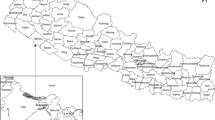Abstract
Dengue fever is an infectious tropical disease caused by the dengue virus. Dengue is transmitted by several species of mosquito within the genus Aedes, principally A. aegypti. The study area of Madurai is located in South Tamilnadu, India. Mapping of geographical distribution and identification of disease risk area is an important element in disease management efforts. The present study demonstrates the significance of geo-medical mapping in identifying the risk zones of vector-borne disease by taking a study of dengue cases in Madurai city. Data on dengue cases recorded during 2011–2015 in 100 wards (unit area) of Madurai city was analyzed. The land use/land cover map prepared from the satellite image of 2016 was spatially correlated. About 0.34% of the population had been affected by dengue during 2011–2015 in the Madurai city with spatial variations at different wards. Location quotient analysis aided the identification of dengue risk zones in Madurai city. Built-up lands and fallow lands are characterized by a large number of water bodies and irrigated crop land making them more vulnerable to dengue. The main objective of the study was to identify the risk zone of dengue disease through geospatial mapping by taking a geomedical study of Madurai city.






Similar content being viewed by others
References
Arunachalam, N., Susilowati, F., Espino, P., Kittayapong, W., Abeyewickreme, W., & Wai, K. T. (2010). Eco-bio-social determinants of dengue vector breeding: A multicounty study in urban and periurban Asia. Bulletin of the World Health Organization, 88(3), 173–184.
Arunachalam, N., Tewari, S. C., Thenmozhi, V., Rajedran, R., Paramasivan, R., Manavalan, R., et al. (2008). Natural vertical transmission of dengue virus by Aedes Aegypti in Chennai, Tamilnadu, India. Indian Journal of Medical Research, 127(4), 395–397.
Bhatt, S., Gething, P. W., Brady, O. J., Messina, J. P., Farlow, A. W., Moyes, C. L., et al. (2013). The global distribution and burden of dengue. Nature, 496(7446), 504–507. https://doi.org/10.1038/nature12060.
Brady, O. J., et al. (2012). Refining the global spatial limits of dengue virus transmission by evidence-based consensus. PLOS Neglected Tropical Diseases, 6(8), e1760. https://doi.org/10.1371/journal.pntd.0001760.
Campbell-Lendrum, D., Manga, L., Bagayoko, M., & Sommerfeld, J. (2015). Climate change and vector–borne diseases: What are the implications for public health research and Policy? Philosophical Transactions of the Royal Society B: Biological Science, 370(1665), 20130552. https://doi.org/10.1098/rstb20130552.
Caraballo, H., & King, K. (2014). Emergency department management of mosquito-borne illness: malaria, dengue, and West Nile virus. Emergency Medicine Practice, 16(5), 1–23.
Centers for Disease Control and Prevention. (CDCP). (2013). What is dengue? WHO report. Updated March 28, 2016. http://wwwnc.cdc.gov/travel/diseases/dengue.
Cromley, E. K., & McLafferty, S. L. (2002). GIS and public health (2nd ed.). New York: The Guilford Press. ISBN 9781609187507.
Duncombe, J., Clements, A., Hu, W., Weinstein, P., Ritchie, S., & Fe Esperanza Espino, F. E. (2012). Geographical information systems for dengue surveillance. American Journal of Tropical Medicine and Hygience, 86(5), 753–755. https://doi.org/10.4269/ajtmh.2012.11-0650.
Florence, P. S. (1939). Report on the location of industry. Political and economic planning. Econometric analysis (4th ed.). London: Greene, W. H 2000.
Gubler, D. J. (1998). Dengue and denguehemorrhagic fever. Clinical Microbiology Reviews, 11(3), 480–496.
Guzman, M. G., & Kouri, G. (1996). Advances in dengue diagnosis. Clinical and Diagnostic Laboratory Immunology, 3(6), 621–627.
Hema Malini, M., Visweswara Reddy, B., Gangaraju, M., Tammi Naidu, G., & Nageswara Roa, K. (2016). Geospatial analysis of filariasis risk in Vizianagaram District of Andhra Pradesh, India. Punjab Geographer, 12(1), 83–96.
Howe, G. M. (1970). Some recent development in disease mapping. Royal Society of Health, 90(1), 16–20.
Malavige, G. N., Fernando, S., Fernando, D. J., & Seneviratne, S. L. (2004). Dengue viral infection. Postgraduate Medical Journal, 80(948), 588–601.
Meade Melinda, S. (1988). Medical geography as human ecology: The dimension of population movement. Geographical Review, 67(4), 379–393.
Phillips, D. R., & Verhasselt, Y. (1989). The future relevance of medical geography for health planning, health and development in the third world. GeoJournal, 19(2), 129–134.
Raheel, U., Faheem, M., Riaz, M. N., Kanwal, N., Javed, F., Zaidi, N. S., et al. (2011). Dengue fever in the Indian subcontinent: An overview. Journal of Infection in Developing Countries, 5(4), 239–247.
Saravanabavan, V., Sudharsan, R., Balaji, D., & Rahamath Nisha, R. (2014). Patient perception and epidemiological characteristics of dengue in Madurai city-using factor analysis. International Journal of Mosquito Research, 1(2), 18–24.
Shannon, G. W. (1977). Space, time and illness behaviour. Social Science & Medicine, 11(14–16), 683–689. https://doi.org/10.1016/0037-7856(77)90154-8.
Vandoros, S., Hessel, P., Leone, T., & Avendano, M. (2013). Have health trends worsened in Greece as a result of the financial crisis? A quasi-experimental approach. European Journal of Public Health, 23(5), 727–731.
Walter, S. D. (1992). The analysis of regional patterns in health data. I. Distributional considerations. American Journal of Epidemiology, 136(6), 730–741.
WHO. (2003). Dengue and severe dengue. Fact sheet no 117. http://www.who.int/mediacentre/factsheets/fs117/en/#. Accessed 12 March 2014.
WHO (2017) Dengue and severe dengue. Fact sheet no 128. http://www.who.int/mediacentre/factsheets/fs117/en/#. Accessed 6 April 2017.
Acknowledgements
The authors gratefully acknowledge the ICSSR (Indian Council of Social Science Research) New Delhi for the financial assistance to carry out this research work. The authors also sincerely thank DST-PURSE, Department of Geography, Madurai Kamaraj University, Madurai.
Author information
Authors and Affiliations
Corresponding author
Ethics declarations
Conflict of interest
Sources of Funding for this research is from ICSSR (Indian Council of Social Science and Research, New Delhi). For this research the compliance with ethical standards is not applicable since only the data collected at various centres are used and identify Dengue Risk zone.
Rights and permissions
About this article
Cite this article
Saravanabavan, V., Balaji, D. & Preethi, S. Identification of dengue risk zone: a geo-medical study on Madurai city. GeoJournal 84, 1073–1087 (2019). https://doi.org/10.1007/s10708-018-9909-9
Published:
Issue Date:
DOI: https://doi.org/10.1007/s10708-018-9909-9




